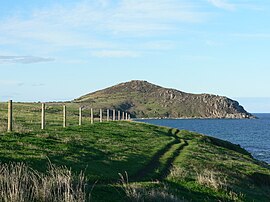Rosetta Head
|
Rosetta Head South Australia |
|
|---|---|

Rosetta Head, west side
|
|
| Coordinates | 35°35′29″S 138°36′14″E / 35.59139°S 138.60389°ECoordinates: 35°35′29″S 138°36′14″E / 35.59139°S 138.60389°E |
| Postcode(s) | 5211 |
| Elevation | 97 m (318 ft) |
| LGA(s) | City of Victor Harbor |
Rosetta Head (also known as Kongkengguwar), which is more commonly known as The Bluff, is a headland located on the south coast of Fleurieu Peninsula in the Australian state of South Australia in the suburb of Encounter Bay within the city of Victor Harbor and about 77 kilometres (48 mi) south of Adelaide. It is a prominent landmark on the coast of Encounter Bay which is currently used as a recreational reserve and which is notable as a platform to view the adjoining coast and surrounding countryside.
Rosetta Head is located in the suburb of Encounter Bay about 3.9 kilometres (2.4 mi) south-west by south of the centre of Victor Harbor and about 77 kilometres (48 mi) south of Adelaide. When viewed from a platform such as a ship, it appears as being ‘a grassy mound, 97 metres (318 ft) high, cliffy on its E(ast) side, and covered with granite boulders; it is steep-to on its E(ast) and S(outh) sides.’ Its southern tip is considered by Australian authorities as being the western extent of Encounter Bay. On its northern side, there is a small wharf which is connected to the adjoining urban area by a road and which adjoins a body of water is known as Rosetta Harbor. On its southern side, there is a small cove called Petrel Cove.
Rosetta Head as a headland was formed when the sea reached its present level 7,500 years ago after sea levels started to rise at the start of the Holocene. As a landform, it is a large domed inselberg which is considered to be ‘the most prominent feature along Encounter Bay coastline’ and whose form is due to its origins via the geological processes of metamorphism and intrusion followed by two phases of erosion; firstly via the action of a northward-moving glacier during the Permian which created the distinctive dome shape and then by wave action from the south due to the sea level rise during the Holocene. When viewed from the adjoining coastline, it is considered to be a typical example of a glacial terrain known as a roche moutonnee. Geologically, Rosetta Head is the result of the intrusion of molten granite (known as Encounter Bay Granite) into a grey metamorphic rock (known as the Kanmantoo group) which was subsequently elevated as part of a mountain building event known as the Delamerian Orogeny between 475 and 500 million years ago. The water adjoining the base of Rosetta Head drops to a maximum depth of 12.8 metres (42 ft) within a distance of 100 metres (330 ft) of its shore.
...
Wikipedia

